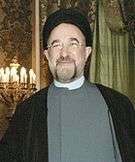Iranian presidential election, 1997
| | |||||||||||||||||||||||||||||||
| |||||||||||||||||||||||||||||||
| |||||||||||||||||||||||||||||||
| |||||||||||||||||||||||||||||||
Iranian presidential election of 1997 took place on 23 May 1997, which resulted in an unpredicted win for the reformist candidate Mohammad Khatami. The election was notable not only for the lopsided majority of the winner - 70% - but for the high turnout. 80% of those eligible to vote did so, compared to 50% in the previous presidential election.[2]
During the election, voting age was 15 and more than half of Iran's population was younger than 25.[3]
Candidates
The Council of Guardians blocked 234 candidates from running for the presidency because they lacked the religious and political qualifications.[4][5] Only four candidates were permitted to run for office:
- Mohammad Khatami, Former Minister of Culture and Islamic Guidance
- Mohammad Reyshahri, Former Minister of Intelligence and National Security
- Reza Zavarei, Member of Guardian Council
- Ali Akbar Nateq-Nouri, Incumbent Speaker of the Parliament of Iran
Disqualified candidates
- Ebrahim Yazdi, secretary-general of Freedom Movement of Iran[6]
- Habibollah Payman, leader of Movement of Militant Muslims[6]
- Ezatollah Sahabi, leading Nationalist-Religious figure[6]
- Azam Taleghani, former member of the Iranian parliament[6]
Declined to run
- Mir-Hossein Mousavi, former Prime Minister[7]
Issues
The candidates were asked about their opinion on the fatwa against Salman Rushdie. Ali Akbar Nateq-Nouri said that any "a good Muslim" would carry out the fatwa.[8] Mohammad Khatami avoided the issue.[8] Mohammad Khatami's supporters called Nateq-Nouri the "Taliban" of Iran.[9]
Khatami ran on a platform of political liberalization at home and détente abroad[10] and expressed support for the easing Islamic regulations "from women's dress to whether TV satellite dishes should be allowed."[11]
Endorsements
Media
During the elections, neutrality of Islamic Republic of Iran Broadcasting (IRIB) became a subject of dispute, as the organization was accused of supporting Nateq-Nouri and promoting conservative agenda.[16]
- Salam supported Khatami[17]
- Hamshahri supported Khatami[18]
- Resalat supported Nateq-Nouri[19]
- Kayhan supported Nateq-Nouri[19]
Results
| Party | Candidate | Votes | Percentage | |||
|---|---|---|---|---|---|---|
| Association of Combatant Clerics | Mohammad Khatami | 20,078,187 | 69.6% | |||
| Combatant Clergy Association | Ali Akbar Nategh-Nouri | 7,242,859 | 25.1% | |||
| Independent | Reza Zavarei | 771,460 | 2.7% | |||
| Association for Defence of Revolution Values | Mohammad Reyshahri | 742,598 | 2.6% | |||
| Blank or invalid votes | 240,996 | |||||
| Totals | 29,067,100 | 100.00% | ||||
| Source: Nohlen, Dieter; Grotz, Florian; Hartmann, Christof (2001). "Iran". Elections in Asia: A Data Handbook. I. Oxford University Press. p. 76. ISBN 0-19-924958-X. | ||||||
References
- 1 2 "1997 Presidential Election", The Iran Social Science Data Portal, Princeton University, retrieved 10 August 2015
- ↑ Abrahamian, Ervand, History of Modern Iran, Columbia University Press, 2008, p.186
- ↑ Fadaee, Simin (2012). Social Movements in Iran: Environmentalism and Civil Society. Routledge. p. 67. ISBN 978-0415693578.
- ↑ Calls for reform grow louder as Iran goes to polls 24 May 1997
- ↑ Iran’s Myth of Moderation 18 March 2002
- 1 2 3 4 Buchta, Wilfried (2000), Who rules Iran?: the structure of power in the Islamic Republic, Washington DC: The Washington Institute for Near East Policy, The Konrad Adenauer Stiftung, pp. 31–32, ISBN 0-944029-39-6
- ↑ Amir Arjomand, Saïd (2009). After Khomeini: Iran Under His Successors. Oxford University Press. p. 92. ISBN 9780199745760.
- 1 2 Rushdie key issue in Iran election 22 May 1997
- ↑ Election farce as Iran chooses its president 22 May 1997
- ↑ Brown, L. Carl (2004). Diplomacy in the Middle East: The International Relations of Regional and Outsid. I.B.Tauris. p. 254. ISBN 1860648991.
- ↑ CNN - Iranians look for economic help from Friday's election - 19 May 1997
- 1 2 3 4 5 6 7 Mohammidi, Ali (2013-02-01). Iran Encountering Globalization: Problems and Prospects. Routledge. p. 214. ISBN 9781136776793.
- ↑ Samii, Abbas W. (Winter 2005), "The Changing Landscape of Party Politics in Iran—A Case Study" (PDF), Journal of the European Society for Iranian Studies (1): 53–62
- ↑ Curtis, Glenn; Hooglund, Eric (2008), Iran, a country study (PDF), Washington, D.C., USA: Library of Congress, p. 231, ISBN 978-0-8444-1187-3
- ↑ Brumberg, Daniel; Farhi, Farideh (2016). Power and Change in Iran: Politics of Contention and Conciliation. Indiana Series in Middle East Studies. Indiana University Press. p. 175.
- ↑ Gholam Khiabany (2009). Iranian Media: The Paradox of Modernity. Routledge. p. 178. ISBN 978-0-203-87641-1.
- ↑ John H. Lorentz (2010). "Khatami, Muhammad". The A to Z of Iran. The A to Z Guide Series. 209. Scarecrow Press. p. 169. ISBN 1461731917.
- ↑ Brumberg, Daniel (2001). Reinventing Khomeini: The Struggle for Reform in Iran. University of Chicago Press. p. 290. ISBN 0226077586.
- 1 2 Basmenji, Kaveh (2013). "Nine: Playing Chess with an Ape". Tehran Blues: Youth Culture in Iran. Saqi. ISBN 0863565158.


